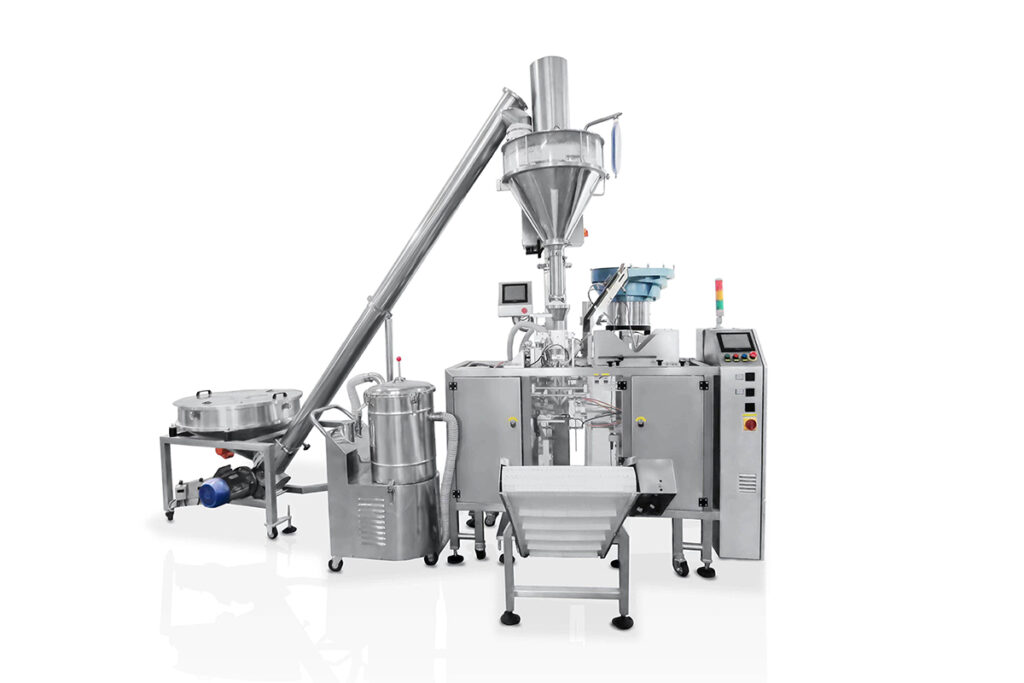An auger filler is a type of packaging machinery commonly used in the food, pharmaceutical, and chemical industries to fill containers, such as bottles, jars, and pouches, with powdered or granular products. It operates on the principle of using an auger screw to meter and dispense the product accurately into containers. Here are the main parts of an auger filler and their functions:
The Auger Filler Definition
Auger filler is a specialized packaging machine used in various industries, such as food, pharmaceuticals, and chemicals, to accurately and efficiently fill powdered or granular products in containers. It operates based on the principle of utilizing an auger screw, typically made of stainless steel, to meter and dispense the product into containers. The rotation of the auger screw conveys the material from a hopper to a filling funnel or nozzle, ensuring precise and controlled filling. Auger fillers are known for their ability to handle a wide range of products and container sizes, making them a versatile and essential tool in the packaging process.
Main Parts of Auger Fillers
The auger filler is made up of different parts, and although they have been around for a while, many manufacturers of the auger filler, including VTOPS, are constantly upgrading the functions and accessories of the auger filler for a better user experience, but some of the parts and functions still the same. Learning the different parts can help you repair and maintain your auger filler. But what are these main parts?
Hopper:
The hopper is a large, conical-shaped container that holds the bulk supply of the product to be filled. It ensures a consistent and continuous flow of material to the auger. Usually the standard hopper volume is 50L. Due to different user needs, auger filler manufacturer VTOPS has developed a 20L silo for desktop use and a 100L silo for large-weight filling. In addition, it should consider the additional functions of the hopper. For example, the function of easy cleaning hopper will be more popular.
Auger Screw:
The auger screw is the central component of the auger filler. It consists of a helical blade (similar to a screw) that rotates inside a tube. As the auger rotates, it conveys and meters the product from the hopper to the filling area. The design of the auger can vary depending on the product’s characteristics and the desired fill volume. The diameter of the auger screw can be as small as 10mm and as large as 70mm. It can even be customized to be smaller or thicker to meet specific needs.
Filling Funnel/Nozzle:
The filling funnel or nozzle is located at the bottom of the auger screw. It directs the product into the containers, ensuring accurate and controlled filling. The size and shape of the funnel/nozzle can be customized to fit different container sizes and shapes.
Agitator:
An agitator is often placed inside the hopper to prevent product bridging or clogging. It helps maintain a consistent flow of material to the auger, ensuring accurate and reliable filling. A agitator is not necessary for free-flowing materials. If you have multiple materials at the same time including free-flowing materials and non-free-flowing materials, you need to consult the auger filler manufacturer whether the intermittent stirring function will be necessary.
Drive Motor:
The drive motor is also a central component of auger filler and powers the auger screw’s rotation. The speed and torque of the motor can be adjusted to control the fill rate and accuracy. Current drive technologies include stepper motor drives and servo motor drives, with servo motors being better.
Control Panel:
The control panel houses the electronic controls and user interface for the auger filler. Operators can set parameters such as fill volume, fill speed, and container indexing through the control panel. Some advanced auger fillers may include touchscreen interfaces for user convenience.
Frame and Base:
The frame and base provide structural support for the auger filler, ensuring stability during operation. They are typically made of stainless steel to meet hygiene and durability standards in the food and pharmaceutical industries.
Sensors and Safety Features:
Auger fillers may be equipped with sensors and safety mechanisms to detect and prevent issues such as container jams, overfills, or other malfunctions. These features help ensure the safety of both the equipment and the operators.
Conveyor System (optional):
Some auger fillers are integrated with conveyor systems that transport containers to the filling station and then to downstream packaging processes, such as capping or sealing.
Product Level Sensors (optional):
In some cases, product level sensors can be installed in the hopper to monitor and maintain a consistent product level. This helps prevent the auger from running empty and ensures continuous filling.
Auger fillers are versatile and can be customized to suit the specific needs of different industries and products, making them a popular choice for filling a wide range of containers with powdered or granular materials.



